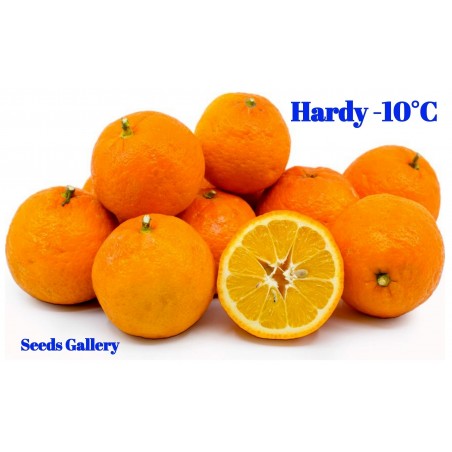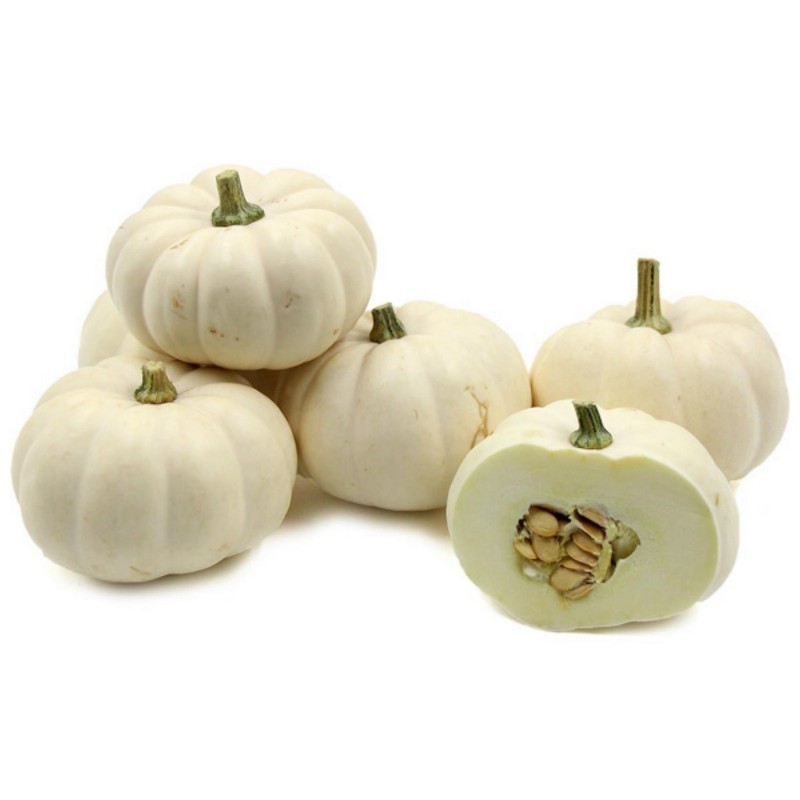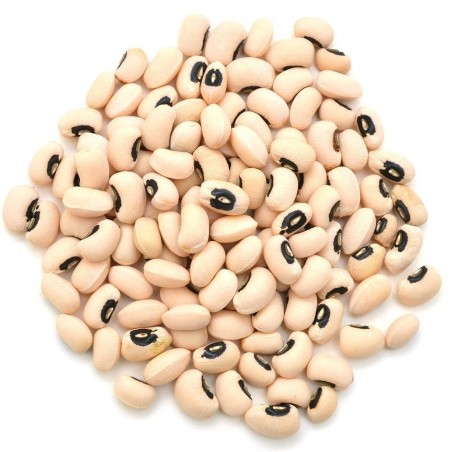
BABY BOO Squash - Pumpkin Seeds
BABY BOO Squash - Pumpkin Seeds
Price for Package of 5 seeds.
C. pepo 100 days. One of our most fun varieties to grow, Baby Boo produces bone-white mini pumpkins that are as enjoyable to look at as they are to eat. A reliably productive variety
BABY BOO Squash - Pumpkin Seeds
Price for Package of 5 seeds.
C. pepo 100 days. One of our most fun varieties to grow, Baby Boo produces bone-white mini pumpkins that are as enjoyable to look at as they are to eat. A reliably productive variety, these palm-sized fruit string on creeping vines like Halloween garlands. For pure white color, harvest prior to full maturity, because this one turns a very pale yellow when fully ripe.
Cucurbita spp.: This traditional ornament of the autumn harvest is good for much more than jack-o-lanterns and pies. High in fiber and essential minerals, their colorful orange flesh signifies an abundance of the antioxidant beta-carotene.
CULTURE: Pumpkins have the same cultural needs as other members of the squash family. Starting transplants indoors can give you earlier yields and prize winning pumpkins. Start transplants 3 weeks prior to your usual last frost. Use 3-inch Peat or Cow pots and grow with lots of light in a warm area. After they are up and growing well, move them to an outside cold frame. Hardening off for about a week makes a difference in their vigor after transplanting. Once the danger of frost has passed, plant the entire Peat or Cow pot, covering completely. Plant the bush or short-vine varieties in rows 6-8 feet apart with the plants spaced 3-4 feet apart in the row. Large-fruited varieties should be planted in rows 8-10 feet apart, with the plants spaced 4-5 feet apart in the row. Pumpkins and gourds require moderate-to-high levels of fertility. One-half cup of our complete fertilizer should be worked in around the plant when transplanting and another at the 4-6 leaf stage. Soil testing and liming to adjust pH can increase your success. Pumpkins and gourds require uniform irrigation totaling 15-20 inches of water during the growing season. Bee attractant flowers or beehives will help yields. Misshapen or non-developing fruit is often the result of poor pollination.
DIRECT SOWING: Plant after your last frost and when the soil has warmed to at least 60°F. Sow with 3-4 feet between bush varieties, and 4-5 feet between vining varieties. Distance between rows: 6-10 feet. Pumpkins need just-barely-damp soils to germinate. Too much moisture causes the seed to rot. All pumpkins are monoecious (bearing separate male and female flowers on the same plant), and require bee and insect activity for successful pollination. Poor fruit set is often the result of poor pollination.
DISEASES: Pumpkins and gourds are susceptible to many of the common vine diseases, such as wilts, leaf spots and mildews, as well as several viral diseases. Common control measures include crop rotation, field sanitation, and fungicide applications. Consult your local county extension agent with specific problems.
INSECTS: Cucumber beetles and squash bugs can cause problems in squash plants. We've seen striped cucumber beetles turn healthy leaves into something that resembles a nylon sack in a matter of days. Dedicated use of Pyrethrin will help control the problem. Crop rotation can minimize problems with insects.
HARVEST: Exposure in the field to prolonged (1-2 weeks) temperatures below 50°F can result in chilling injury and lead to pumpkins and gourds rotting in storage. Pumpkins can be harvested after their rinds are hard and their skins have turned orange. Leave 3-4 inches of stem on the fruit since pumpkins without stems store poorly. Gourds should be allowed to mature as long as possible on the vine. To dry gourds, first wash gently in a solution of 10 parts water and 1 part bleach, carefully removing all dirt, then store in a warm, dry location. Pumpkins and gourds should be stored at 55-70°F and at 70% relative humidity.
| HEIRLOOM ? | Yes |
|---|---|
| Organic Seeds ? | Organic Seeds |
| Organic/natural ? | Organic/Natural: Yes |
| Edible ? | Edible |
| Pretreatment of sowing ? | Soak in water before sowing 12-24 h |
| Sowing depth ? | Sowing depth 3 mm |
| Life Cycle: | Annual Plant: Yes |
| Handpicked seeds ? | Handpicked seeds |


Your review appreciation cannot be sent
Report comment
Report sent
Your report cannot be sent
Write your review
Review sent
Your review cannot be sent
🌍 Worldwide Shipping from the EU
We ship worldwide from the European Union using registered air post with signature confirmation on delivery.
📦 Tracking Your Order
Log in to your account and go to Order History > Details to find your tracking number.
You will receive email notifications at every step — please check your spam/junk folder if you don’t see them.
Track your package via:
⚠️ Important Notices
Cash on delivery is not available.
Always provide a valid mobile number with country code when ordering (e.g., +365 456 7686 576).
Do not order to P.O. Boxes or if you cannot be home to sign for the package. We cannot leave parcels with neighbors.
If a package sent to a P.O. Box is lost or undelivered, you lose the right to a refund.
📦 Lost, Returned & Reshipping Packages
For customers in Brazil and Mexico:
We cannot refund packages lost or destroyed by customs.
If your package is returned, we will refund only the product cost — shipping costs are not refundable.
You must pay return postage (€2) and any costs for reshipping.
If a package is returned to us for any reason, you are responsible for paying the return shipping (€2) plus the cost to resend the package.
🚚 Shipment Delivery
Registered shipments require a signature from the recipient.
If your tracking shows the package is still at the origin post office, it means the package is in transit — please contact your local post office directly for updates.
We are not responsible for delivery times and cannot track shipments for you.
📅 Delivery Options & Estimated Times
Delivery Option Processing Time Notes Priority Delivery Ships in 1-7 business days Prioritizes order processing (not guaranteed faster delivery); delays possible during holidays (3-10 days) Secured Delivery Ships in 1-7 business days Available for orders up to €150; refund if lost Standard Delivery Ships in 7-10 business days More economical; delays possible during holidays (7-14 days) Estimated Delivery Time:
Within the EU: 3–20 days
Worldwide: 5–30 days
Example delivery times to the USA:
Delivered in 13, 17, 19, 22, or 27 days.Note: Delivery times depend on your location and the local postal system. COVID-19 may cause additional delays.
💰 Shipping Costs
Shipping and handling fees are calculated automatically during checkout based on the weight of the parcel and the destination country.
⏰ Order Processing Hours
We do not process or ship orders on Saturdays or Sundays.
💳 Payment Options
Bank Transfer (SEPA / IBAN / SWIFT-BIC)
Include your order reference in the payment description (e.g., "SGS-19811702"). Orders without payment within 7 days are automatically cancelled.PayPal
Payments accepted in Euros only. Please select Euros at checkout.Card Payment
For card payments, visit our other site: Exotic Seeds Store
We accept Visa, MasterCard, American Express, CB, Diners Club, Discover, China UnionPay, JCB, and Discover.
⚠️ Transaction Fees
Customers are responsible for any transaction fees. Please provide payment details to help us process your order efficiently.
📢 Final Notes
Before placing your order, please check our website for any special notices, holiday schedules, or specific conditions that may affect your purchase.
Related Products















